
Concept explainers
(a)
Interpretation:
The possible structures of the starting materials of the given Diels-Alder product are to be given.
Concept introduction:
In order to find the starting materials of the given compounds follows the rules are given below.
First, label the double bond carbons as
In order to complete the diene structure, eliminate the double bonds between
In order to complete the dienophile structure, add the double bonds between its carbons.
Also, dienophile is substituted with electron withdrawing groups.
Answer to Problem 15.20P
The possible structures of starting materials of given compound can be as follows.
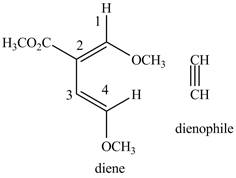
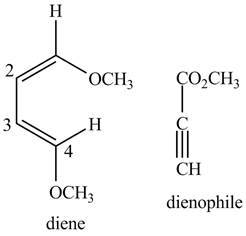
Explanation of Solution
First designate the double bond carbon atoms as
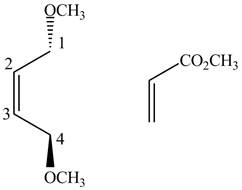
Figure 1
In order to complete the structure of diene, remove the double bonds present between carbons
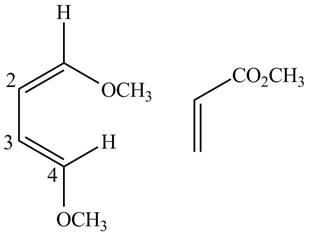
Figure 2
Finally, complete the dienophile structure by adding the double bonds between carbons.
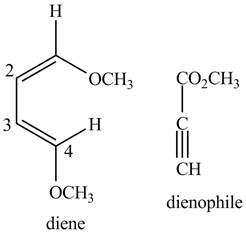
Figure 3
Similarly, second possibility on the basis of above mentioned steps will be as follows.
First designate the double bond carbons as
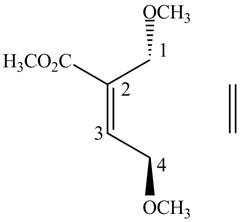
Figure 4
In order to complete the structure of diene, remove the double bonds present between carbons

Figure 5
Finally, complete the dienophile structure by adding the double bonds between carbons
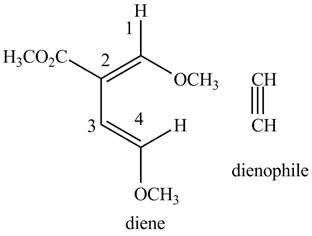
Figure 6
The possible starting materials of the given compound are shown in Figure 3 and Figure 6.
(b)
Interpretation:
The possible structures of the starting materials of the given Diels-Alder product are to be given.
Concept introduction:
First, label the double bond carbons as
In order to complete the diene structure, eliminate the double bonds between
In order to complete the dienophile structure, add the double bonds between its carbons.
Also, dienophile is substituted with electron withdrawing groups.
Answer to Problem 15.20P
The possible structures of starting materials of given compound are shown below.
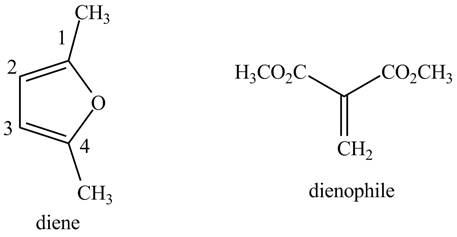
Explanation of Solution
First designate the double bond carbons as

Figure 7
In order to complete the structure of diene, remove the double bonds present between carbons
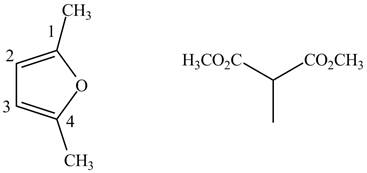
Figure 8
Finally, complete the dienophile structure by adding the double bonds between carbon atoms.
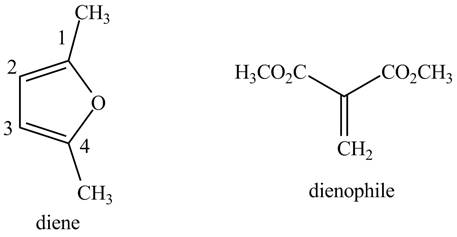
Figure 9
The possible starting materials of given compound are shown in Figure 9.
(c)
Interpretation:
The possible structures of the starting materials of the given Diels-Alder product are to be given.
Concept introduction:
First, label the double bond carbons as
In order to complete the diene structure, eliminate the double bonds between
In order to complete the dienophile structure, add the double bonds between its carbons.
Also, dienophile is substituted with electron withdrawing groups.
Answer to Problem 15.20P
The possible structures of starting materials of given compound are as follows.

Explanation of Solution
First designate the double bond carbons as
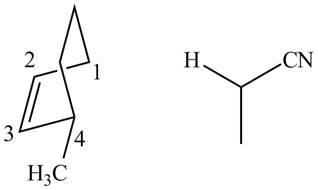
Figure 10
In order to complete the structure of diene, remove the double bonds present between carbons
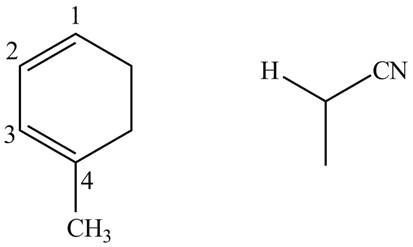
Figure 11
Finally, complete the dienophile structure by adding the double bonds between carbons.
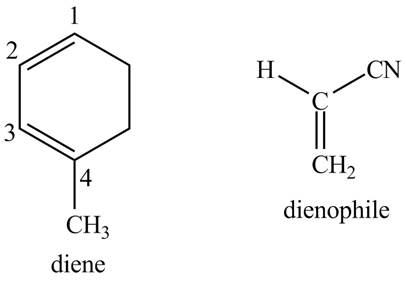
Figure 12
The possible starting materials of given compound are shown in Figure 12.
(d)
Interpretation:
The possible structures of the starting materials of the given Diels-Alder product are to be given.
Concept introduction:
First, label the double bond carbons as
In order to complete the diene structure, eliminate the double bonds between
In order to complete the dienophile structure, add the double bonds between its carbons.
Also, dienophile is substituted with electron withdrawing groups.
Answer to Problem 15.20P
The possible structures of starting materials of given compound are as follows.
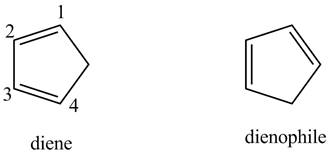
Explanation of Solution
First designate the double bond carbons as

Figure 13
In order to complete the structure of diene, remove the double bonds present between carbons
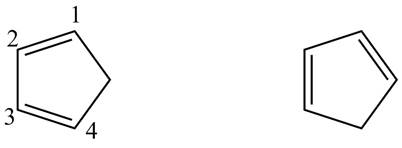
Figure 14
Finally, complete the dienophile structure by adding the double bonds between carbons.

Figure 15
The possible starting materials of given compound are shown in 15.
Want to see more full solutions like this?
Chapter 15 Solutions
ORGANIC CHEMISTRY (LL)+ SAPLING ACC >BI
- Suggest reactivity of compound A, B and C in increasing order of E2 reactionarrow_forwardProvide a reasonable synthetic strategy for the synthesis of a racemic mixture of (1R,2R) and (1S,2S)-2-bromo-1-methylcyclopentanol from the compound shown below... Provide the bond line structure for the major organic products obtained in each step of the proposed strategyarrow_forwardBringing together your knowledge of the reaction chemistry of substituted benzenes, suggest a preparative route for conversion of compound A to compound B shown belowarrow_forward
- Answer the following question pertaining to the reaction of maleic anhydride and 1,3-butadiene: - Specify the conformation required to enable a 1,3-diene to undergo the Diels-Alderreactionarrow_forwardThe sex attractant of the female arctiid moth contains, among other components, a compound of molecular formula C21H40 that yields on ozonolysis. What is the constitution of this material?arrow_forwardDraw the products for these Diels-Alder reactions with correct relative (or absolute) configuration of all formed stereocenters. Explain the stereochemical outcome assuming the involvement of secondary interactions whenever possible.arrow_forward
- Draw the structure of the desired dibromide product H. ) Propose a reasonable arrow-pushing mechanism for formation of the byproduct I.Use your mechanism to justify the stereochemistry in molecule Iarrow_forwardArrange these compounds in order of reactivity towards electrophilic aromaticsubstitution, with the most reactive compound listed firstarrow_forwardFor the following structure, propose the starting materials necessary to form it through a Diels- Alder reaction. Hint: You may need to pay attention to the configuration of the dene and or dienophilearrow_forward
- Rank A, B, and C in order of increasing SN1 reactivity.arrow_forwardStarting with acid chloride with exactly 5 carbon atoms, and using appropriate reagents outline the synthesis of the following molecules:arrow_forward1. If diene is used in excess for a Diels-alder reaction of a-phellandrene and malice acid, which side reaction would be expected? Use chemical equations to support your answer. 2. If methanol was used instead of diethyl ether as the reaction solvent and left tp reflux longer than necessary, what side reactions would you expect to happen. in the reaction flask. Use a chemical equation to support your answer.arrow_forward
 Organic ChemistryChemistryISBN:9781305580350Author:William H. Brown, Brent L. Iverson, Eric Anslyn, Christopher S. FootePublisher:Cengage Learning
Organic ChemistryChemistryISBN:9781305580350Author:William H. Brown, Brent L. Iverson, Eric Anslyn, Christopher S. FootePublisher:Cengage Learning
